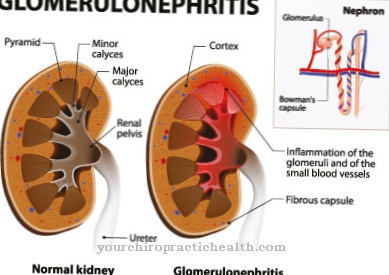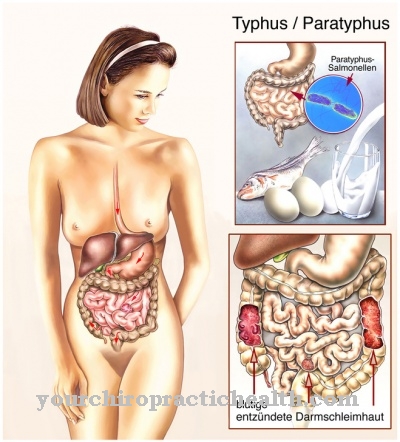If the boundary between the external auditory canal and the middle ear is no longer there, there is a risk of one Cholesteatomawhich then makes surgical treatment inevitable.
What is a cholesteatoma?

Cholesteatoma is a disease of the ears. By nature, the ears are divided into different sections, including the external ear canal and middle ear. Both sections are cut off from each other by the eardrum.
In the majority of cases with cholesteatoma, this barrier is defective, which means that the middle ear is no longer naturally sealed off from the external auditory canal. As a result, components of the external auditory canal can grow into the middle ear and, in the worst case, even into the inner ear, which can then lead to a cholesteatoma.
The growth of squamous epithelia into the middle ear can destroy the structure of the bones there, which then leads to the typical appearance of a cholesteatoma: dead skin layers that are particularly stable due to their structure. A final, white corneal layer also forms over the partly destroyed bone structure of the middle ear. Due to the elimination of the natural demarcation barrier, secretions from the middle ear can now also flow into the external auditory canal and cause inflammatory reactions there.
The biggest problem with this is the risk of superinfection. This denotes an infection with various pathogens, each of which favor the occurrence of the other, which makes therapy much more difficult. The typical symptoms of cholesteatoma include the foul smelling odor due to the inflammation in the ear, dizziness and - depending on the severity of the disease - numbness.
causes
As already mentioned, the cause of cholesteatoma is the fact that the tympanic membrane is no longer intact, i.e. the isolation between the external auditory canal and the middle ear is no longer guaranteed. Squamous epithelia of the external auditory canal can now grow into the middle ear and destroy the bone structure there.
A distinction is made between primary and secondary cholesteatoma, depending on whether the loss of function of the ear field was triggered by inflammation. In addition, there is a variant of cholesteatoma, even if it occurs rarely, in which a defect in the eardrum, whether inflammatory or non-inflammatory, does not even have to be present.
This is a congenital defect in which the squamous epithelia form behind an (intact) eardrum in the middle ear and lead to the cholesteatoma.
You can find your medication here
➔ Medicines for earache and inflammationSymptoms, ailments & signs
In the case of a cholesteatoma, those affected suffer from various hearing problems and thus from a significant reduction in quality of life. In severe cases, the affected person can also completely lose their hearing, and this loss cannot be restored. First and foremost, however, a cholesteatoma leads to a strong discharge from the ear, which is associated with a very unpleasant odor.
This smell also has a negative effect on the social environment of the person concerned, so that difficulties can arise in this area. It can also lead to bullying or teasing children, so that they develop psychological complaints and depression. In the further course, a cholesteatoma leads to hearing loss and severe dizziness. In doing so, the patient can also lose consciousness and faint.
Paralysis of the face can also occur, so that the ingestion of food and liquids is no longer possible for the person concerned. This leads to pain in the ears, which can spread to the head. Fever can also occur and be associated with a general feeling of illness. As a rule, however, the cholesteatoma has no influence on the life expectancy of the person affected.
diagnosis
A cholesteatoma can be diagnosed relatively easily. For the trained eyes of an ear, nose and throat doctor, visual diagnosis using an ear microscope is sufficient. Based on the relatively clear clinical picture, he can determine the presence of a cholesteatoma.
However, in order to determine how advanced the cholesteatoma is, i.e. how far it protrudes into the middle ear, further diagnostic measures are required. Computer tomography (CT for short) is one of the most common.
Complications
A cholesteatoma usually has ear complications. You may experience severe earache. In many cases, the pain from the ears spreads to the neighboring regions, so that most patients also suffer from headaches and toothaches.
In the worst case, facial paralysis occurs and the affected person suffers hearing loss. The pain is often not permanent, but only sporadic. However, a loss of hearing is noticeable for those affected. The face is also paralyzed, so that certain muscles cannot be moved.
This can also lead to paralysis of the tongue or the mouth, so that the patient can no longer eat normally. The paralysis of the tongue can also lead to speech disorders. The quality of life is severely restricted by the cholesteatoma and everyday life is made considerably more difficult for the patient. The symptoms often lead to depression and thoughts of suicide.
The restoration of the auditory ossicles is unfortunately not possible in every case, so that in the worst case the patient has to live his entire life with a hearing loss. If surgery is possible, antibiotics are used to prevent inflammation. Life expectancy is not reduced by the cholesteatoma.
When should you go to the doctor?
Usually, a cholesteatoma definitely needs medical evaluation and treatment. In most cases, those affected need an operation. A doctor should definitely be consulted if sudden hearing loss or severe ear pain occurs. A bad smelling discharge from the ear can also indicate the cholesteatoma and should be examined by a doctor.
In many cases, patients suffer from dizziness or paralysis in various areas of the face. If these symptoms also occur, medical treatment is definitely necessary. A fever with a headache can also indicate the cholesteatoma. Above all, the sudden onset of these complaints and the hearing loss suggests cholesteatoma.
A hospital can also be visited in an emergency. Generally, however, cholesteatoma is diagnosed and treated by an ENT specialist. With early treatment, the disease usually progresses positively.
Doctors & therapists in your area
Treatment & Therapy
The only way to treat a cholesteatoma is by surgical removal. The affected ear is cut open so that the cholesteatoma can be cut away with a scalpel.
Then an attempt is made to restore the tympanic field in order to counteract a possible recurrence of the cholesteatoma by treating the cause. As far as possible, the final attempt is made to repair the damage to the bone structure of the middle ear caused by the cholesteatoma.
Before you can operate, however, it is important to treat an existing superinfection. The administration of antibiotics is intended to kill the bacteria that have settled there, otherwise there is a risk that the bacteria will spread further during an operation.
Outlook & forecast
Cholesteatoma has a favorable prognosis in most patients. The tumor on the ear can be removed in a surgical procedure. In many cases, the overgrowth leads to inflammation, which must also be treated so that, ultimately, freedom from symptoms can be achieved.
People who have a stable immune system experience a regression of the inflammation within a few weeks through drug therapy. The older the patient is and the weaker his health, the longer the healing process will normally be. Nevertheless, there is a good chance of a cure here too.
The operation is associated with the usual risks and side effects. These must be taken into account when making the prognosis. With good medical care there are generally no impairments after treatment. The usual hearing ability is restored as the healing process subsides.
If the cholesteatoma is only recognized and treated at a very advanced stage, permanent damage can occur. The risk of hearing impairment or changes in the bone structure in the ear increases as the growth in the ear increases. In very rare cases, the growth of the cholesteatoma has already reached areas of the brain. The patient is then in a life-threatening condition, as a stroke can occur.
You can find your medication here
➔ Medicines for earache and inflammationprevention
The trigger of the cholesteatoma is the loss of the eardrum; This first made it possible for squamous epithelia to grow into the middle ear, which could then lead to the later inflammation. The prophylaxis of cholesteatoma can therefore only be limited to keeping the eardrum intact and preventing damage.
Since inflammation can also lead to a defect in the eardrum, careful ear hygiene is recommended. However, this must not be exaggerated, as otherwise the natural skin flora of the ears could be permanently damaged, which would not only not prevent, but could promote the colonization of pathogens and thus a cholesteatoma.
Aftercare
After the surgical treatment of the cholesteatoma, a tamponade usually remains in the affected person's ear canal for one to three weeks. Only after removing this protective device can you check how successful the therapy was. In all cases it is not possible to determine the extent to which hearing has been restored on the day of removal.
In some patients, another operation to check the functionality of the ear canal is necessary in a year. In principle, follow-up appointments are only necessary sporadically for procedures that are free of complications. However, if a so-called radical ear cavity was created during the operation, it is advisable to have this medically treated at regular intervals.
Pain after the operation of the cholesteatoma is not to be expected with uncomplicated interventions. In this case, the superficial healing of the wounds is complete after about two weeks. However, wound healing is delayed, particularly when using an ear radical cavity. This can take a few weeks to months.
In this case, the patient should take care to avoid the ingress of water (especially soapy water) and dirt. Daily living activities can be resumed about a week after surgery. Sports activities such as swimming and diving can be excluded from this. Anyone who would like to pursue these activities should discuss this with the treating doctor. How long a patient is unable to work after an operation depends on the one hand on the extent of the medical intervention and on the other hand on the work content.
You can do that yourself
The treatment of a cholesteatoma primarily focuses on removing the narrowing of the ear canal that caused it and, at the same time, alleviating the symptoms. The sufferer can take some measures to support the treatment and to reduce the discomfort.
After an operation, the affected ear must be spared. The sick person is advised to avoid cold, especially drafts. Other influences such as extreme heat or vibrations must also be avoided, because otherwise serious complications can arise.
In the worst case, the surgical scar tears open and has to be operated again. If you experience unusual symptoms such as earache, fever or dizziness after the procedure, the responsible doctor must be informed. In addition, the doctor's specifications regarding wound care should be observed.
A cholesteatoma can usually be treated well, but requires extensive monitoring by the responsible doctor. After the treatment has been completed, the affected ear must be checked regularly by the ear specialist. In some cases a cholesteatoma forms again, which must be treated surgically. If hearing problems or even hearing loss have set in, a hearing aid must be worn.


.jpg)





















.jpg)



